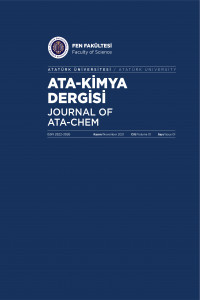SARS-CoV-2'nin NSP12 proteinine karşı glukoza bağlı kumarin türevlerinin in silico çalışması ve yapı-aktivite ilişkileri
SARS-CoV-2, COVID-19, Koronavirüs, Kumarin, İlaç tasarımı, Moleküler yerleştirme
In silico study and structure-activity relations of glucose-bound coumarin derivatives against the NSP12 protein of SARS-CoV-2
SARS-CoV-2, COVID-19, Coronavirus, Coumarin, Drug design, Molecular docking.,
___
- REFERENCES
- [1] Heidary, F., Gharebaghi, R. “Ivermectin: a systematic review from antiviral effects to COVID-19 complementary regimen” The Journal of antibiotics, (2020),73(9), 593-602.
- [2] Lai, C-C., Shih, T-P., Ko, W-C., Tang, H-J., Hsueh, P-R. “Severe acute respiratory syndrome coronavirus 2 (SARS-CoV-2) and coronavirus disease-2019 (COVID-19): The epidemic and the challenges” International journal of antimicrobial agents, (2020), 55(3), 105924.
- [3] Xu, P., Zhou, Q., Xu, J. “Mechanism of thrombocytopenia in COVID-19 patients” Annals of hematology, (2020), 99(6), 1205-1208.
- [4] Jain U. Effect of COVID-19 on the Organs. Cureus. 2020;12(8).
- [5] Khailany, R.A., Safdar, M., Ozaslan, M. “Genomic characterization of a novel SARS-CoV-2” Gene reports, (2020), 19, 100682.
- [6] Mittal, A., Manjunath, K., Ranjan, R.K., Kaushik, S., Kumar, S., Verma, V. “COVID-19 pandemic: Insights into structure, function, and hACE2 receptor recognition by SARS-CoV-2” PLoS pathogens, (2020), 16(8), e1008762.
- [7] Hall, Jr D.C., Ji, H-F. “A search for medications to treat COVID-19 via in silico molecular docking models of the SARS-CoV-2 spike glycoprotein and 3CL protease” Travel medicine and infectious disease, (2020), 35, 101646.
- [8] Dehelean, C.A., Lazureanu, V., Coricovac, D., Mioc, M,. Oancea, R., Marcovici, I., et al. “SARS-CoV-2: repurposed drugs and novel therapeutic approaches—insights into chemical structure—biological activity and toxicological screening” Journal of clinical medicine, (2020), 9(7), 2084.
- [9] Wang, Q., Zhang, Y., Wu, L., Niu, S., Song, C., Zhang, Z., et al. “Structural and functional basis of SARS-CoV-2 entry by using human ACE2” Cell, (2020), 181(4), 894-904.
- [10] Hati, S., Bhattacharyya, S. “Impact of Thiol–Disulfide Balance on the Binding of Covid-19 Spike Protein with Angiotensin-Converting Enzyme 2 Receptor” ACS omega, (2020), 5(26), 16292-16298.
- [11] Bao, L., Deng, W., Huang, B., Gao, H., Liu, J., Ren, L., et al. “The pathogenicity of SARS-CoV-2 in hACE2 transgenic mice” Nature, (2020), 583(7818), 830-833.
- [12] Sun, X-Y., Liu, T., Sun, J., Wang, X-J. “Synthesis and application of coumarin fluorescence probes” RSC Advances, (2020), 10(18), 10826-10847.
- [13] Küpeli Akkol, E,. Genç, Y., Karpuz, B., Sobarzo-Sánchez, E., Capasso, R. “Coumarins and coumarin-related compounds in pharmacotherapy of cancer” Cancers, (2020), 12(7), 1959.
- [14] Pivetta, T., Valletta, E., Ferino, G., Isaia, F., Pani, A., Vascellari, S., et al. “Novel coumarins and related copper complexes with biological activity: DNA binding, molecular docking and in vitro antiproliferative activity” Journal of inorganic biochemistry, (2017), 177, 101-109.
- [15] Basile, A., Sorbo, S., Spadaro, V., Bruno, M., Maggio, A., Faraone, N., et al. “Antimicrobial and antioxidant activities of coumarins from the roots of Ferulago campestris (Apiaceae)” Molecules, (2009), 14(3), 939-952.
- [16] Golfakhrabadi, F., Abdollahi, M., Ardakani, M.R.S., Saeidnia, S., Akbarzadeh, T., Ahmadabadi, A.N., et al. “Anticoagulant activity of isolated coumarins (suberosin and suberenol) and toxicity evaluation of Ferulago carduchorum in rats” Pharmaceutical biology, (2014), 52(10), 1335-1340.
- [17] Shen, Y-F., Liu, L., Feng, C-Z., Hu, Y., Chen, C., Wang, G-X., et al. “Synthesis and antiviral activity of a new coumarin derivative against spring viraemia of carp virüs” Fish & shellfish immunology, (2018), 81, 57-66.
- [18] Singh, L.R., Avula, S.R., Raj, S., Srivastava, A., Palnati, G.R., Tripathi, C., et al. “Coumarin–benzimidazole hybrids as a potent antimicrobial agent: synthesis and biological elevation” The Journal of antibiotics, (2017), 70(9), 954-961.
- [19] Hu, Y., Shen, Y., Wu, X., Tu, X., Wang, G-X. “Synthesis and biological evaluation of coumarin derivatives containing imidazole skeleton as potential antibacterial agents” European journal of medicinal chemistry, (2018), 143, 958-969.
- [20] Lingaraju, G.S., Balaji, K.S., Jayarama, S., Anil, S.M., Kiran, K.R., Sadashiva, M.P. “Synthesis of new coumarin tethered isoxazolines as potential anticancer agents” Bioorganic & medicinal chemistry letters, (2018), 28(23-24), 3606-3612.
- [21] Özdemir, M., Köksoy, B., Ceyhan, D., Bulut, M., YALCİN, B. “In silico, 6LU7 protein inhibition using dihydroxy-3-phenyl coumarin derivatives for SARS-CoV-2” Journal of the Turkish Chemical Society Section A: Chemistry. (2020) 7(3), 691-712.
- [22] Özdemir, M., Köksoy, B., Ceyhan, D., Sayın, K., Erçağ, E., Bulut, M., et al. “Design and in silico study of the novel coumarin derivatives against SARS-CoV-2 main enzymes” Journal of Biomolecular Structure and Dynamics, (2020), 1-16.
- [23] Kow, C.S., Sunter, W., Bain, A., Zaidi, S.T.R., Hasan, S.S. “Management of outpatient warfarin therapy amid COVID-19 pandemic: a practical guide” American Journal of Cardiovascular Drugs, (2020), 20, 301-309.
- [24] Trott, O., Olson, A.J. “AutoDock Vina: improving the speed and accuracy of docking with a new scoring function, efficient optimization, and multithreading” Journal of computational chemistry, (2010), 31(2), 455-461.
- [25] Yin, W., Mao, C., Luan, X., Shen, D-D., Shen, Q., Su, H., et al. “Structural basis for inhibition of the RNA-dependent RNA polymerase from SARS-CoV-2 by remdesivir” Science, (2020), 368(6498), 1499-1504.
- [26] BIOVIA DS. Discovery Studio Visualizer. San Diego: Dassault Systèmes2021.
- [27] Schrödinger. Maestro. Release 2021-2 ed. LLC, New York, NY: Schrödinger; 2021.
- [28] Daina, A., Michielin, O., Zoete, V. “SwissADME: a free web tool to evaluate pharmacokinetics, drug-likeness and medicinal chemistry friendliness of small molecules” Scientific reports, (2017), 7(1), 1-13.
- [29] Banerjee, P., Eckert, A.O., Schrey, A.K., Preissner, R. “ProTox-II: a webserver for the prediction of toxicity of chemicals” Nucleic acids research, (2018), 46(W1), W257-W63.
- [30] Lipinski, C.A., Lombardo, F., Dominy, B.W., Feeney, P.J. “Experimental and computational approaches to estimate solubility and permeability in drug discovery and development settings” Advanced drug delivery reviews, (1997), 23(1-3), 3-25.
- Başlangıç: 2021
- Yayıncı: Atatürk Üniversitesi
Celal Tuğrul ZEYREK, Ertuğrul Gazi SAĞLAM, Sabire AYDIN
Kimya fabrikalarında ve kümelerinde domino etkilerinin tarihsel bakış açısı ile incelenmesi
Esra ÇELİK, Mücahit ÖZDEMİR, Bahattin YALÇIN, Baybars KÖKSOY
Kumarin ve izokumarin türevlerinin anti-enflamatuar aktivite profillerinin araştırılması
